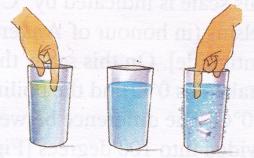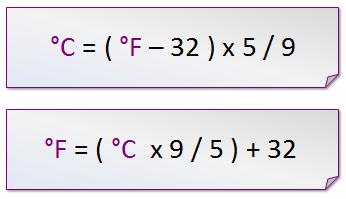What is Temperature and Can Temperature be Measured Directly
Temperature
The degree of ‘hotness’ or ‘coldness’ of a body or a place is called temperature.
One of the methods of measuring the degree of hotness and coldness is by the sense of touch. But our sense of touch can sometimes be misleading. Let us look at the following experiment to understand why!
Activity
Aim: To show that the terms ‘hot’ and ‘cold’ as we feel them are only relative terms
Materials needed: Three glasses, hot water (as hot as you can bear to dip your finger in), ice-cold water, and water at room temperature
Method:
1. Pour hot water, water at room temperature, and the ice-cold water into three separate glasses.
2. Keep the three glasses side by side on a table with the glass containing water at room temperature in the middle.

3. Dip the index finger of one hand in the ice-cold water and that of the other hand in the hot water. Hold the fingers in the water for a minute.
4. Then dip both the index fingers into the water at room temperature.
Observation: You will find that to one finger, the water feels hot and to the other it feels cold. Conclusion: This is because the finger that was in ice-cold water has become cold, and when it was placed in the water at room temperature, it felt that the water was warm, relative to the earlier experience of ice-cold water. Similarly, the finger that was first in hot water will feel the water at room temperature to be relatively cold.
So, you see the terms ‘hot’ and ‘cold’ are only relative terms. There must always be a reference body with respect to which we can say a given body is hot or cold.
Therefore, it is important that we use an instrument, rather than our own judgement, to measure temperature.
Measurement of Temperature
We measure temperature with an instrument called the thermometer. All thermometers measure temperature by making use of some property of a substance that varies with temperature. One such property is the change in volume of a substance (expansion and contraction) with temperature.
Temperature Scales
Just as we use different units to measure length (inches, centimetres, etc.), we use different units to measure temperature. These different units are represented by different temperature scales.
Here is a simplified description of how a temperature scale is defined. Two reference temperatures are chosen and the difference between these two temperatures are further broken down into a certain number of divisions. Each division is called one degree.
The most commonly used reference temperatures are the melting point of ice and the boiling point of water.
The three commonly used scales are the Celsius, the Fahrenheit scales, and the Kelvin scale.
- Celsius Scale
This scale is indicated by °C [read as degree Celsius (in honour of Anders Celsius) or degree centigrade]. On this scale, the melting point of ice is taken as 0°C and the boiling point of water, as 100°C. The difference between these two points is divided into 100 degrees. - Fahrenheit Scale
This scale is indicated by °F (read as degree Fahrenheit). On this scale, 32°F is taken as the melting point of ice and 212°F as the boiling point of water. The difference between these two points is divided into 180 degrees.
Conversion of Temperature
Conversion Formula
Two simple equations given below will help us to convert one temperature scale into another.
F = (C x \(\frac{9}{5}\)) + 32, and
C = \(\frac{5}{9}\) (F – 32), where F is for Fahrenheit and C is for Celsius.

Fet us look at the following examples to understand the conversion properly.
Example 1: Convert 86°F to °C.
Solution: We know that
C = \(\frac{5}{9}\) (F – 32)
= \(\frac{5}{9}\) (86 – 32)
= \(\frac{5}{9}\) × 54
Therefore, 86°F = 30°
Example 2: The temperature during a hot day in Delhi was 45°C. Express this temperature in degree Fahrenheit.
Solution:
We know that F = (C x \(\frac{9}{5}\)) + 32
We are given that C = 45°C, therefore, the day temperature in degree Fahrenheit
= (45 x \(\frac{9}{5}\)) + 32°F = (81+ 32)°F = 113°F
Types of Thermometers
The substance that is generally used in a conventional thermometer is either mercury or alcohol. Based on this, there are two types of thermometers: mercury thermometer and alcohol thermometer.
Mercury Thermometer
In 1714, Gabriel Fahrenheit invented the first mercury thermometer.
Mercury is used in thermometers because of the following reasons:
- Mercury remains in the liquid state for a wide range of temperatures. It melts at -38.87°C and boils only at 356.58°C.
- It is relatively easy to see because of its silvery grey colour.
- It does not stick to glass.
- It has a fairly uniform rate of expansion for a wide range of temperatures.
Alcohol Thermometer
Thermometers using alcohol have some advantages over mercury thermometers.
- Alcohol is cheaper and less harmful than mercury.
- Alcohol thermometers can measure much lower temperatures (up to -115°C) than mercury. However, the main disadvantage is that alcohol thermometers cannot measure temperatures higher than 78°C, whereas mercury thermometers can measure much higher temperatures.
Reading a Conventional Thermometer
The thermometers we use in the laboratory are called laboratory thermometers and the ones used to check body temperature are called clinical thermometers.
A laboratory thermometer is shown in Figure. It consists of a thin glass tube which is sealed at one end and has a bulb at the other end. The bulb is generally filled with mercury or alcohol, depending on whether it is a mercury or an alcohol laboratory thermometer. Mercury appears as a silvery grey line and alcohol looks like a red line in the thermometer. To read the temperature on this thermometer, you just read the number on the scale at the tip of the red or silvery-grey line. Remember to mention the unit used (Celsius or Fahrenheit).
The range of temperatures which a laboratory thermometer can measure is from -10°C to 110°C.

A clinical thermometer is generally a mercury thermometer though digital thermometers are becoming quite popular.
There are two characteristic features of a clinical thermometer:
- There is a little arrow (at 98.4 or 98.6°F) showing the normal body temperature. .
- There is a constriction or ‘kink’ in the tube near the bulb. This kink has been made to ensure that the mercury in the thermometer does not contract (and flow back into the bulb) before the temperature has been read.
To read the body temperature of any person with a clinical thermometer, follow the steps given below:

Here are some precautions that one must follow while handling a mercury clinical thermometer.
- Wash the thermometer well and dip it in an antiseptic liquid before and after using it.
- Be careful while using a thermometer. It can break easily. Remember, mercury is a toxic substance.
The temperature of our body is closely related to a physical quantity called ‘heat’ or ‘heat energy’ possessed by the body. Let us learn more about this physical quantity.